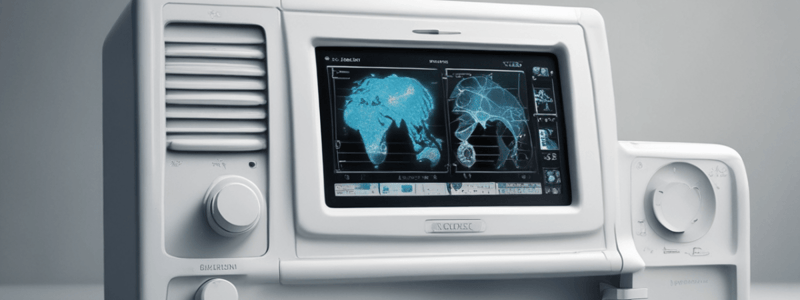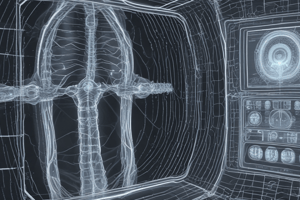Podcast
Questions and Answers
What event spurred the advancement of SONAR technology?
What event spurred the advancement of SONAR technology?
- The discovery of X-rays
- The development of MRI
- World War I's naval warfare (correct)
- World War II
Who identified the piezoelectric effect?
Who identified the piezoelectric effect?
- Spallanzani
- The Dussik brothers
- The Curie brothers (correct)
- Langevin
What was the focus of Dussik's pioneering study?
What was the focus of Dussik's pioneering study?
- The brain (correct)
- The liver
- The heart
- The kidneys
In what year did Spallanzani explore the discovery of sound beyond the audible spectrum?
In what year did Spallanzani explore the discovery of sound beyond the audible spectrum?
What was the development of in the 1940s?
What was the development of in the 1940s?
Who created an early ultrasound device using piezoelectric principles?
Who created an early ultrasound device using piezoelectric principles?
What was developed in the 1930s?
What was developed in the 1930s?
What was the outcome of institutions worldwide developing pulsed ultrasound technology?
What was the outcome of institutions worldwide developing pulsed ultrasound technology?
What expansion occurred in ultrasound technology?
What expansion occurred in ultrasound technology?
What type of energy do sound waves carry?
What type of energy do sound waves carry?
What is the standard unit of power?
What is the standard unit of power?
How many milliwatts are in a single Watt?
How many milliwatts are in a single Watt?
What is intensity in the context of sound waves?
What is intensity in the context of sound waves?
What is the unit of beam area in ultrasound?
What is the unit of beam area in ultrasound?
What happens to intensity when the area increases?
What happens to intensity when the area increases?
What is the effect of focusing on intensity?
What is the effect of focusing on intensity?
What happens to an ultrasound pulse as it travels through a medium?
What happens to an ultrasound pulse as it travels through a medium?
What is the term for the weakening of an ultrasound pulse as it travels through a medium?
What is the term for the weakening of an ultrasound pulse as it travels through a medium?
What does the sonographer adjust to achieve optimal imaging depth?
What does the sonographer adjust to achieve optimal imaging depth?
What is the relationship between PRP and PRF?
What is the relationship between PRP and PRF?
What happens to PRP when PRF increases?
What happens to PRP when PRF increases?
What is the typical range of PRP values in clinical imaging?
What is the typical range of PRP values in clinical imaging?
What influences the determination of PRP?
What influences the determination of PRP?
What is pulse-repetition period (PRP)?
What is pulse-repetition period (PRP)?
What is the effect of increasing PRF on the time between pulses?
What is the effect of increasing PRF on the time between pulses?
What can the operator adjust to change the PRP?
What can the operator adjust to change the PRP?
What is the unit of PRP?
What is the unit of PRP?
What is the formula for SPL?
What is the formula for SPL?
What is the relationship between frequency and SPL?
What is the relationship between frequency and SPL?
What is the axial resolution dependent on?
What is the axial resolution dependent on?
What is the length of space over which a pulse occurs?
What is the length of space over which a pulse occurs?
What is the effect of increasing path length on attenuation?
What is the effect of increasing path length on attenuation?
What is the effect of higher frequencies on attenuation?
What is the effect of higher frequencies on attenuation?
How does the attenuation coefficient change with frequency?
How does the attenuation coefficient change with frequency?
What is the average loss of attenuation per MHz frequency?
What is the average loss of attenuation per MHz frequency?
What is the unit of measurement for acoustic impedance?
What is the unit of measurement for acoustic impedance?
What is the formula for calculating acoustic impedance?
What is the formula for calculating acoustic impedance?
What happens when there is a substantial difference in acoustic impedance between two tissues?
What happens when there is a substantial difference in acoustic impedance between two tissues?
What happens when the acoustic impedance of two tissues is similar?
What happens when the acoustic impedance of two tissues is similar?
What is the density of air in kg/m³?
What is the density of air in kg/m³?
What is the speed of ultrasound in air in m/s?
What is the speed of ultrasound in air in m/s?
What is the density of water in kg/m³?
What is the density of water in kg/m³?
What is the speed of ultrasound in water in m/s?
What is the speed of ultrasound in water in m/s?
What is the density of blood in kg/m³?
What is the density of blood in kg/m³?
Flashcards are hidden until you start studying
Study Notes
Evolution of Ultrasound Technology
- Ultrasound technology evolved from SONAR technology, which was developed during World War I for naval warfare.
- In 1880, Spallanzani discovered sound beyond the audible spectrum, leading to the development of ultrasound technology.
- The Curie brothers, Pierre and Jacques, identified the piezoelectric effect in 1794, which is fundamental to later ultrasound technology.
- In the 1930s, diagnostic uses for ultrasound started to emerge, marking a new era in medical imaging.
- The real-time B-scan ultrasound was developed in the 1960s, and three-dimensional (3D) and four-dimensional (4D) ultrasound technology expanded in the following years.
Sound Wave Parameters: Power
- Power is the capacity of a wave to displace particles within a medium.
- The standard unit of power is the Watt (W), and in diagnostic ultrasound, power is commonly expressed in milliwatts (mW).
- One milliwatt equates to one-thousandth of a Watt.
Sound Wave Parameters: Intensity
- Intensity is the rate at which energy passes through a unit area.
- Intensity is equal to the power in a wave divided by the area over which the power is spread.
- Intensity units include milliwatts per centimeter squared (mW/cm2) and watts per centimeter squared (W/cm2).
- An increase in area decreases intensity, while a decrease in area (focusing) increases intensity.
Attenuation
- Attenuation is the progressive reduction in amplitude or intensity of ultrasound waves as they travel through a medium.
- Attenuation is caused by the absorption of sound energy, the reflection and scattering of sound waves.
- Factors influencing attenuation include path length, frequency, and tissue type.
- Attenuation is measured in decibels (dB).
Pulse Repetition Period (PRP)
- Pulse-repetition period (PRP) is the time from the beginning of one pulse to the beginning of the next one.
- PRP is the reciprocal of Pulse Repetition Frequency (PRF), expressed in milliseconds or any unit of time.
- PRP decreases while PRF increases because, when more pulses occur in a second, the time between them decreases.
- Typical values for PRP in clinical imaging range from 100 microseconds to 1 millisecond.
Spatial Pulse Length (SPL)
- Spatial pulse length (SPL) is the length of space over which a pulse occurs.
- SPL is equal to wavelength multiplied by the number of cycles in the pulse.
- SPL determines axial resolution.
Ultrasound Interaction with Tissue
- Attenuation coefficient is half the frequency (MHz), resulting in an average loss of 0.5 dB/cm per MHz frequency.
- Acoustic impedance (Z) is influenced by tissue density and the speed of ultrasound, and is calculated using the formula Z = ρ x C.
- The transmission and reflection of ultrasound at tissue interfaces are influenced by acoustic impedance disparities.
Studying That Suits You
Use AI to generate personalized quizzes and flashcards to suit your learning preferences.




